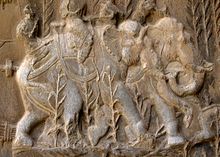Persian war elephants
This article needs additional citations for verification. (February 2011) |

War elephants were used in Iranian military history, most notably in Achaemenid, Seleucid and Sasanian periods. The elephants were Asian elephants, and were recruited from South Asian provinces of Persia[citation needed], but also possibly Western Asiatic elephants from mainland Iran.
Origin, training, and weaponry


The elephants were hired as mercenary troops with their riders. They came from Indian territories under Persian rule. Some historians say that some were from Iran. They were called the Syrian elephant but this may be incorrect.
Persian war elephants were trained by their rider, called a mahout, who would also ride the elephant into battle. The mahouts were of Indian origin, and so were the archers. Training elephants was a difficult task and they would be hard to maintain because they ate so much food and water. On the march, huge paths needed to be cut for the elephants. Many were kept in the shah's menagerie the most famous of which was Khosrau II where he kept a "thousand white elephants."
Persian elephants were from Indian origin and were probably armed with Indian styled weapons. The men(excluding the driver) sat in a large tower from which troops would fight. The elephant itself would normally be armed with thin plate armour (the Sassanids used chain mail as well as thin plate armour)and would bear a large crenelated wooden howdah on its back.[1] The troops would be armed with bow and arrows and javelin. The sworn enemy of the Sassanids, the Eastern Roman empire, were terrified by the huge beasts, making them very effective in battle. When they were used at the Battle of al-Qādisiyyah, they came to be known as "double edged weapons". King ( shah ) Yazdgerd III attempted to use war elephants to fight off Arab invaders, however his elephants got sand in their eyes and panicked. They turned around and ran amok, killing their own troops.
History
Under the Achaemenids
Persians used war elephants at the Battle of Gaugamela in 331 BC. The battle raged between king Alexander the Great of Macedon and king Darius III of Persia. The Persians had 15 Indian-trained war elephants, which were placed at the centre of the Persian line, and they made such an impression on the Macedonian troops that Alexander felt the need to sacrifice to the God of Fear the night before the battle. Despite this the Persians lost the battle, relinquishing the Achaemenid empire to Alexander.
Some[citation needed] claim that they had been used previously in the Greek campaign of King Xerxes I of Persia, and even further back at the time of Darius the Great at the Indus, the Danube and against the Scythians in 512 BC. Neither Xenophon nor Herodotus mention war elephants in their accounts of these earlier campaigns.
This section needs expansion. You can help by adding to it. (October 2010) |
Under the Sasanians
| Military of the Sasanian Empire |
|---|
| Armed forces and units |
| Ranks |
| Defense lines |
| Conflicts |
Elephants were later used by the Sassanids under a special chief, known as the Zend−hapet, or "Commander of the Indians", as they were from India.

Persian war elephants are recorded in Armenian sources during the Battle of Avarayr in 451 AD, between the Sasanians under Yazdegerd II and Armenian rebels under Vartan Mamikonian.
The elephants were also used as a shooting platform during sieges. According to Procopius, emperor Justinian I had raised Dara's city walls by 30 feet (9.1 m) to hinder attacks by elephants.[2]
Eight elephants were present in Mihr-Mihroe's army in his campaign in 551.
In the Battle of the Bridge near the fall of the Sasanian Empire, the Sasanians under Bahman Jaduyah used their elite Zhayedan forces, which included war elephants, against the invading Arab Muslims under Abu Ubaid al-Thaqafi. A white elephant tore the latter from his horse with its trunk, and trampled him under foot. The Arab Muslims suffered heavy casualties in the battle.[3] The elephants was also used in the Battle of al-Qādisiyyah, but was unsuccessful.
Later dynasties
The war elephants were also used by Saffarids, Ghaznavids, and to a lesser extent Buyids.[4]
In popular culture
- Shatranj (Persian chess) - which Modern chess has gradually developed from it, same as Indian chess includes the war elephant with the name fil (meaning "elephant" in Persian) as the bishop.
- The Persian civilisation in Age of Empires 2 has War Elephants as their unique unit, in reference to this period in history
See also
- War elephant
- Crushing by elephant
- Sassanid army
- History of elephants in Europe
- List of historical elephants
- Military animals
- Cavalry tactics
References
- ^ Michael B. Charles, ‘The Rise of the Sassanian Elephant Corps: Elephants and the Later Roman Empire’, Iranica Antiqua 42 (2007) 301-346
- ^ Acta Antiqua Academiae Scientiarum Hungaricae. Akadémiai Kiadó. 2003. p. 369.
- ^ Richard Nelson Frye, The Cambridge History of Iran: The period from the Arab invasion to the Saljuqs, (Cambridge University Press, 1975), 8-9.
- ^ https://books.google.com/books?id=qKdkCgAAQBAJ&lpg=PA91&pg=PA92
- David Nicolle, Sassanian Armies : the Iranian empire early 3rd to mid-7th centuries AD (Montvert Publishing 1996). ISBN 1-874101-08-6
- Philip Rance, ‘Elephants in Warfare in Late Antiquity’, Acta Antiqua Academiae Scientiarum Hungaricae 43 (2003) 355-384
- Peter Wilcox, Rome's Enemies 3: Parthians and Sassanid Persians (Osprey Publishing 2001). ISBN 0-85045-688-6
Encyclopædia Iranica
